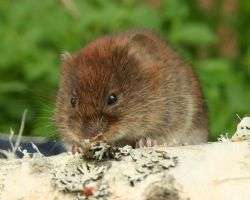Population density and testes size: More than meets the eye

A team of researchers has discovered that changes in population density can affect the size of animals' testes and therefore impact on reproduction.
Across the animal kingdom, there is usually a positive relationship between sperm competing to fertilize eggs and the male reproductive effort in producing large ejaculates. This usually manifests in males evolving larger testes.
However, demographic and ecological processes may drastically alter the level of sperm competition and therefore the evolution of testes size.
A study has been conducted to find out whether testes size responds to natural fluctuations in density of 5 species of wild promiscuous voles.
The results have been published in Proceedings of the Royal Society B: Biological Sciences.
Females of many species mate with multiple males within a single reproductive cycle. When the sperm of two or more males compete for fertilisation, selection acts on a number of traits that enhance success such as sperm size and longevity. The number of sperm is key to success, which typically means males evolving larger testes.
Using long-term longitudinal data from five vole species in northern Finland, the team from the University of Jyvaskyla, Finland, University of Lincoln, UK, and the Finnish Forest Research Institute found that some species show the predicted increase in testes size with population density.
However, when density changed dramatically between years, this relationship can be reversed in some species.
Lead author Dr Ines Klemme from the University of Jyvaskyla, Finland, said: "Large changes in population density can affect competition not only for reproduction, but also for other resources such as space and food. These could potentially alter the ability of males to be able to produce reproductive tissue."
Co-author Dr Carl Soulsbury, from the School of Life Sciences, University of Lincoln, added: "Knowing if testes size can respond to rapid and large natural changes in sperm competition is an important evolutionary question. The results suggest our understanding of sperm competition in fluctuating populations is still very limited."
More information: Ines Klemme, Carl D. Soulsbury, Heikki Henttonen 'Contrasting effects of large density changes on relative testes size in fluctuating populations of sympatric vole species' Proceedings of Royal Society B: Biological Sciences 2014 281, 20141291 rspb.royalsocietypublishing.or … 92/20141291.abstract
Journal information: Proceedings of the Royal Society B
Provided by University of Lincoln

















